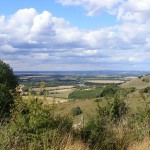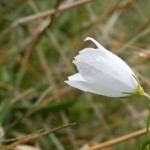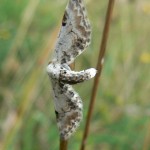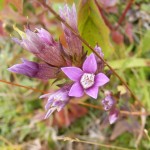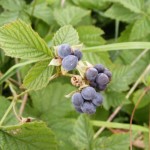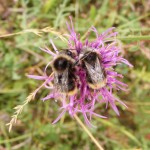Martin Sell led a walk on the southern part of Aston Rowant National Nature Reserve on Saturday 9th September. Starting from the Cowleaze Wood car park, the group crossed the road, started down the track opposite, then turned north across the field above the Linky Down section of the reserve. Common Centaury and the semi-parasitic Red Bartsia were in flower in the field and Speckled Wood, Small Heath and Common Blue butterflies were seen. There were extensive views over to the northern section of the reserve and far across the Oxfordshire lowlands. The walk continued downwards along a sunken track. Amongst the blue Harebells were a few white specimens. Plants here included the seed-heads of Common Rock-rose, Wild Basil, Small Scabious, Yellow-wort and eyebright. A small gentian just coming into flower on the other side of the fence was identified as Autumn Gentian. The ant-hill rich pasture above the bank on the north side of the track was looking heavily grazed by the resident sheep. A Clouded Yellow butterfly was seen here. Both Common and Chalkhill Blue butterflies were roosting with wings together in the shelter of the vegetation at the side of the path. In the relatively cool conditions, they were quite sluggish and could be picked up for closer inspection. The route then crossed a flowery pasture which had not been recently grazed. Flowers here included Blue Fleabane, Small Scabious, Marjoram (including some plants with white flowers) and a clump of Betony near the hedge. A distinctive ragwort was keyed out as Oxford Ragwort. Several Silver Y moths and a Lime-speck Pug were seen here.
The route back started up the track, as far as a big Hornbeam which was covered in witches’ brooms. A path to the right then led into the bottom of the Bald Hill section of the reserve. There were many flowering gentians here – most the larger Chiltern Gentians, with transverse wrinkles up the outside of the corolla tube and a relatively short calyx at its base. But some of the gentians were smaller and were perhaps hybrids between Autumn and Chiltern Gentians. A small white-flowered specimen looked like Autumn Gentian. A number of large bumble bees were resting on gentian flower-heads. Squinancywort and Rest-harrow flowers were added to the list here. A large Juniper bush which had been in good condition earlier in the season now had a number of dead brown patches, raising the worrying fear that it may be showing signs of attack from the Phytophthora pathogen which has been attacking Junipers in other parts of the country. In the scrubby section next to the path between the 2 fields were a number of Dewberry plants, with sharp, juicy berries of a dusky blue. A few Frog Orchids were found near the top of the final slope. Close to the entrance to the field were several spikes of Greater Butterfly Orchids – long past flowering, but protected by wire cages from grazing animals. At this point, a late-comer who had set out the opposite way round the reserve appeared – and he reported the sighting of yet another member who had also failed to meet up with the main party. The first drops of rain began to fall and everyone hurried back to the cars, reaching shelter before the rain turned into a downpour with accompanying thunder and lightning. Finally, the last of the latecomers emerged from the storm.
Pictures by Rob Stallard and Laurie Haseler

